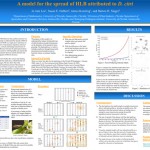A model for the spread of HLB attributed to Diaphorina citri
|
|||||||
Poster Supplemental Information |
|||||||
| A poster presentation at the Third Annual Citrus Health Research Forum in Fort Collins, CO in August 2012. The purpose of the poster is to understand the dual pathways of adult/nymph-to-nymph transmission and its impact on the dynamics of the spread of citrus greening.This is joint work with Susan Halbert, Burt Singer, and James Keesling. |  |
||||||
Model I – Procedure |
|||||||
| This video clip shows the infected trees in a grove, simulated using the standard model (Model I). The red dots on the left side represent the time as the computer speed is slower with more trees that are infected. | |||||||
Figures |
|||||||
|
Trees Producing Infected AdultsFigure 1 compare the number of trees that produce infected psyllids between models. Figure 2 compares the effect of varying the rates of the Adult/Nymph-to-Nymph transmission while assuming the vertical transmission is 5%. Figure 1 compares the standard model (blue line) having latent
period 90 days with the proposed model (red line) having dual pathways of adult/nymph-to-nymph transmission in a simulated grove with 10,000 trees. Figure 2 uses the proposed model to compare te effect of
varying adult/nymph-to-nymph transmission while holding the vertical transmission constant at 5%. |
|||||||
References |
|||||||
|
|||||||